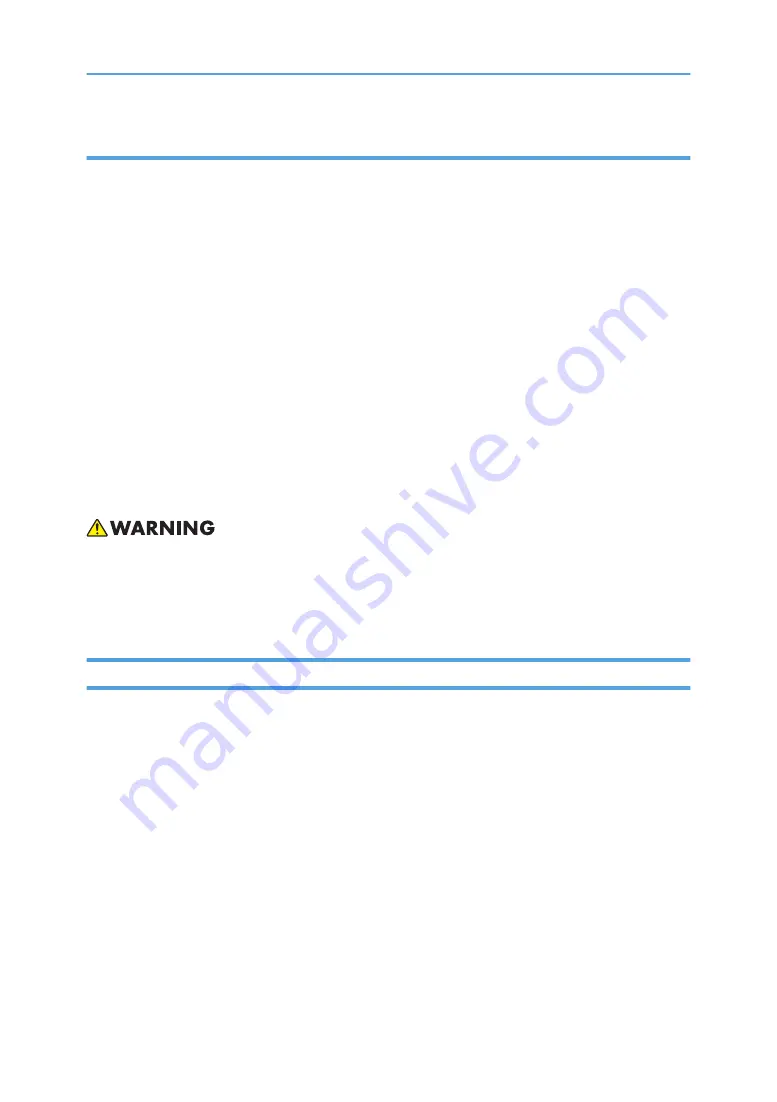
Handling Toner
• Work carefully when removing paper jams or replacing toner bottles or cartridges to avoid spilling
toner on clothing or the hands.
• If toner is inhaled, immediately gargle with large amounts of cold water and move to a well
ventilated location. If there are signs of irritation or other problems, seek medical attention.
• If toner gets on the skin, wash immediately with soap and cold running water.
• If toner gets into the eyes, flush the eyes with cold running water or eye wash. If there are signs of
irritation or other problems, seek medical attention.
• If toner is swallowed, drink a large amount of cold water to dilute the ingested toner. If there are
signs of any problem, seek medical attention.
• If toner spills on clothing, wash the affected area immediately with soap and cold water. Never use
hot water! Hot water can cause toner to set and permanently stain fabric.
• Always store toner and developer supplies such as toner and developer packages, cartridges, and
bottles (including used toner and empty bottles and cartridges) out of the reach of children.
• Always store fresh toner supplies or empty bottles or cartridges in a cool, dry location that is not
exposed to direct sunlight.
• Do not use a vacuum cleaner to remove spilled toner (including used toner). Vacuumed toner may
cause a fire or explosion due to sparks or electrical contact inside the cleaner. However, it is
possible to use a cleaner designed to be dust explosion-proof. If toner is spilled over the floor,
sweep up spilled toner slowly and clean up any remaining toner with a wet cloth.
Safety and Ecological Notes for Disposal
1. Do not incinerate toner bottles or used toner. Toner dust may ignite suddenly when exposed to an
open flame.
2. Dispose of used toner, the maintenance unit which includes developer or the organic
photoconductor in accordance with local regulations. (These are non-toxic supplies.)
3. Dispose of replaced parts in accordance with local regulations.
4. When keeping used lithium batteries in order to dispose of them later, do not put more than 100
batteries per sealed box. Storing larger numbers or not sealing them apart may lead to chemical
reactions and heat build-up.
2
Содержание Gim-MF1a
Страница 1: ...Model Gim MF1a b Machine Code M172 M173 Field Service Manual September 2014...
Страница 2: ......
Страница 32: ...2 Installation 30...
Страница 46: ...2 Operation Panel A x 5 4 Replacement and Adjustment 44...
Страница 55: ...PCDU PCDU 1 Press the release button and open the front cover A 2 Hold the grip to pull the PCDU A out PCDU 53...
Страница 73: ...4 Remove the bracket of the drawer connector and then remove the screws of the thermistor x3 Fusing 71...
Страница 105: ...2 Rear Cover Switch A x 1 Hook Electrical Components 103...
Страница 122: ...5 Operation Panel page 43 Operation Panel 4 Replacement and Adjustment 120...
Страница 125: ...Service Program Mode 123...
Страница 184: ...6 Troubleshooting 182...
Страница 192: ...MEMO 190...
Страница 193: ...MEMO 191...
Страница 194: ...MEMO 192 EN...
Страница 195: ...Model Gim MF1a b Machine Code M172 M173 Appendices September 2014...
Страница 196: ......
Страница 214: ...1 Appendices Specifications 18...
Страница 299: ...MEMO 103...
Страница 300: ...MEMO 104 EN...






















